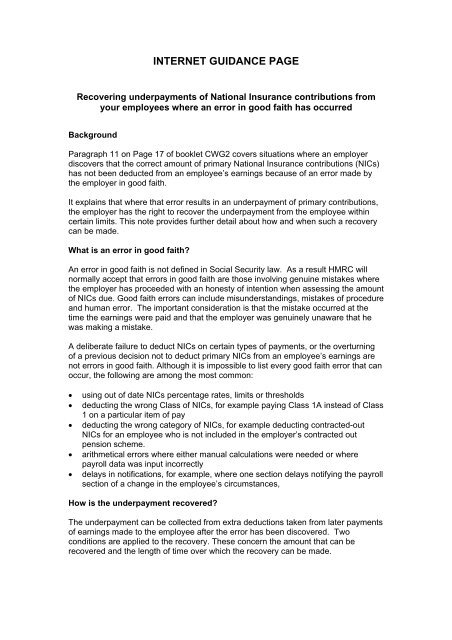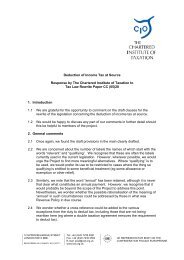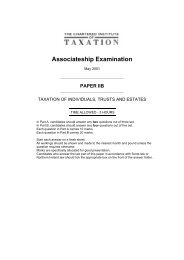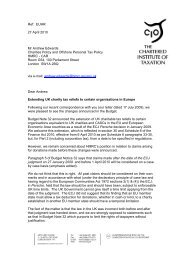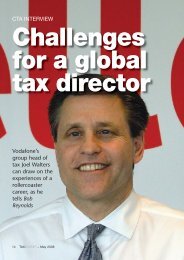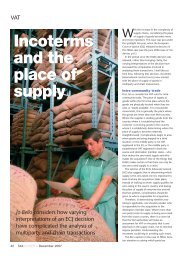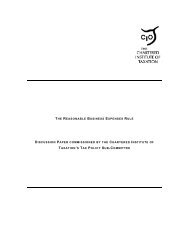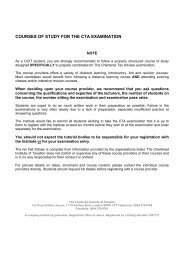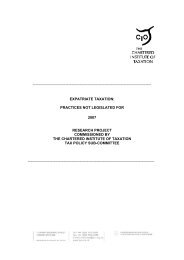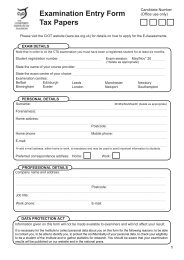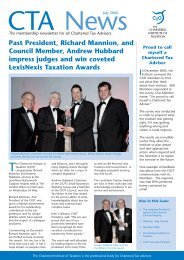Errors in good faith: recovering NICs
Errors in good faith: recovering NICs
Errors in good faith: recovering NICs
Create successful ePaper yourself
Turn your PDF publications into a flip-book with our unique Google optimized e-Paper software.
INTERNET GUIDANCE PAGERecover<strong>in</strong>g underpayments of National Insurance contributions fromyour employees where an error <strong>in</strong> <strong>good</strong> <strong>faith</strong> has occurredBackgroundParagraph 11 on Page 17 of booklet CWG2 covers situations where an employerdiscovers that the correct amount of primary National Insurance contributions (<strong>NICs</strong>)has not been deducted from an employee’s earn<strong>in</strong>gs because of an error made bythe employer <strong>in</strong> <strong>good</strong> <strong>faith</strong>.It expla<strong>in</strong>s that where that error results <strong>in</strong> an underpayment of primary contributions,the employer has the right to recover the underpayment from the employee with<strong>in</strong>certa<strong>in</strong> limits. This note provides further detail about how and when such a recoverycan be made.What is an error <strong>in</strong> <strong>good</strong> <strong>faith</strong>?An error <strong>in</strong> <strong>good</strong> <strong>faith</strong> is not def<strong>in</strong>ed <strong>in</strong> Social Security law. As a result HMRC willnormally accept that errors <strong>in</strong> <strong>good</strong> <strong>faith</strong> are those <strong>in</strong>volv<strong>in</strong>g genu<strong>in</strong>e mistakes wherethe employer has proceeded with an honesty of <strong>in</strong>tention when assess<strong>in</strong>g the amountof <strong>NICs</strong> due. Good <strong>faith</strong> errors can <strong>in</strong>clude misunderstand<strong>in</strong>gs, mistakes of procedureand human error. The important consideration is that the mistake occurred at thetime the earn<strong>in</strong>gs were paid and that the employer was genu<strong>in</strong>ely unaware that hewas mak<strong>in</strong>g a mistake.A deliberate failure to deduct <strong>NICs</strong> on certa<strong>in</strong> types of payments, or the overturn<strong>in</strong>gof a previous decision not to deduct primary <strong>NICs</strong> from an employee’s earn<strong>in</strong>gs arenot errors <strong>in</strong> <strong>good</strong> <strong>faith</strong>. Although it is impossible to list every <strong>good</strong> <strong>faith</strong> error that canoccur, the follow<strong>in</strong>g are among the most common:• us<strong>in</strong>g out of date <strong>NICs</strong> percentage rates, limits or thresholds• deduct<strong>in</strong>g the wrong Class of <strong>NICs</strong>, for example pay<strong>in</strong>g Class 1A <strong>in</strong>stead of Class1 on a particular item of pay• deduct<strong>in</strong>g the wrong category of <strong>NICs</strong>, for example deduct<strong>in</strong>g contracted-out<strong>NICs</strong> for an employee who is not <strong>in</strong>cluded <strong>in</strong> the employer’s contracted outpension scheme.• arithmetical errors where either manual calculations were needed or wherepayroll data was <strong>in</strong>put <strong>in</strong>correctly• delays <strong>in</strong> notifications, for example, where one section delays notify<strong>in</strong>g the payrollsection of a change <strong>in</strong> the employee’s circumstances,How is the underpayment recovered?The underpayment can be collected from extra deductions taken from later paymentsof earn<strong>in</strong>gs made to the employee after the error has been discovered. Twoconditions are applied to the recovery. These concern the amount that can berecovered and the length of time over which the recovery can be made.
1. The amount that can be recoveredThe extra <strong>NICs</strong> deductions can be no greater than the <strong>NICs</strong> deduction which is dueon the earn<strong>in</strong>gs that are about to be paid.ExampleAn employee’s share of <strong>NICs</strong> on a payment of earn<strong>in</strong>gs which is about to be made is£30. The maximum extra deduction that can be made from that payment is also £30,mak<strong>in</strong>g a total deduction from those earn<strong>in</strong>gs of £60.2. The length of time over which the recovery can be made.The extra deductions can be made from any earn<strong>in</strong>gs paid to the employee dur<strong>in</strong>gthe rema<strong>in</strong>der of the tax year <strong>in</strong> which the error was discovered and before the end ofthe next tax year.ExampleAn employer discovers a <strong>good</strong> <strong>faith</strong> error on 28 th February 2007. He may make extradeductions from any earn<strong>in</strong>gs paid to the employee dur<strong>in</strong>g the period 1 st March 2007to 5 th April 2008. This means he has the rema<strong>in</strong>der of the 2006/2007 tax year andthe whole of the 2007/2008 tax year <strong>in</strong> which to recover the underpayment.What should be reported on End of Year returns?It is important to remember that, even if the employer needs to extend the recoveryperiod <strong>in</strong>to the second tax year, the contributions actually due for the year <strong>in</strong> whichthe underpayment occurred must be paid to HMRC at the correct time and must berecorded on the employee’s End of Year Summary (form P14) for that year.ExampleAn employer holds a valid ‘certificate of election’ which authorises him to deductcontributions at the reduced rate for a female employee. The employee is divorcedon 28th April 2006 and becomes liable to pay contributions at the full standard rate.The employer has <strong>in</strong> place arrangements for employees to notify changes to theirmarital status but, whilst the employee complies with these, the notification getsmislaid en route to the payroll department and it is not acted upon until July 2006.As a result, an underpayment of primary contributions occurs dur<strong>in</strong>g the periodbetween the employee’s divorce and the date the payroll section received thenotification. S<strong>in</strong>ce the error giv<strong>in</strong>g rise to the underpayment was made <strong>in</strong> <strong>good</strong> <strong>faith</strong>,the employer can, if necessary, recover the underpayment from any further earn<strong>in</strong>gspaid to the employee <strong>in</strong> the rema<strong>in</strong>der of the 2006/2007 tax year (Year 1) and thefollow<strong>in</strong>g year, 2007/2008 (Year2).The employer must pay over the full amount of primary <strong>NICs</strong> due by the end of the2006/2007 tax year and ensure that the 2006/2007 End of Year Return for theemployee shows the correct NI due for that year, whether or not any rema<strong>in</strong><strong>in</strong>gunderpayment cont<strong>in</strong>ues to be collected dur<strong>in</strong>g 2007/2008.What if an employer is unable to recover the full amount by the end of thesecond tax year?If the employer is unable to recover the full amount by the end of the second taxyear, the employer has to bear the cost of the balance himself.
Po<strong>in</strong>ts for employers to remember:• correct any wrong entries on the employee’s Deductions Work<strong>in</strong>g Sheet (formP11 or equivalent) for Year 1. Advice on how to do this is given <strong>in</strong> Helpbook E13,Day-to-day payroll• ensure that contributions at the correct rate are deducted from any furtherearn<strong>in</strong>gs paid to the employee• start to recover from the employee the amount underpaid. Remember that theextra deduction to be made from any further earn<strong>in</strong>gs can be no greater than theemployee’s contribution due on those earn<strong>in</strong>gs• even if the amount underpaid is not recovered by the end of Year 1, ensure thatthe contributions actually due for that year are both paid to HMRC and recordedon the employee’s P14• <strong>in</strong> Year 2, cont<strong>in</strong>ue to recover any rema<strong>in</strong><strong>in</strong>g underpayment from further earn<strong>in</strong>gspaid to the employee but do not show any further recovery made <strong>in</strong> Year 2 on theemployee’s P14 for Year 2• if unable to recover the full amount underpaid by the end of Year 2, the employerhas to bear the cost of any amount unrecovered.
GUIDANCE FOR THE CWG2 – REPLACEMENT FOR PARA 11Recover<strong>in</strong>g underpayments from your employeesThe position on recover<strong>in</strong>g underpayments from your employees is as follows.For <strong>NICs</strong> purposesAs a general rule, you as the employer have to pay any underpayment of <strong>NICs</strong>aris<strong>in</strong>g from an error.If the error was made, for example, <strong>in</strong> the current tax year you must:• correct any wrong entry on the employee’s Deduction Work<strong>in</strong>g Sheet (formP11 or equivalent)• record on form P14, End of Year Summary, the contributions that areactually due, not those wrongly deducted• pay the amount actually due.However, there are special rules which allow you to recover underpayments fromyour employees where the error was made <strong>in</strong> <strong>good</strong> <strong>faith</strong>.This is done by mak<strong>in</strong>g extra deductions from any later earn<strong>in</strong>gs you pay thatemployee. There are two conditions that apply to these recoveries.1. The extra deduction you can make from any further payment of earn<strong>in</strong>gs canbe no greater than the employee’s contribution due on that further payment ofearn<strong>in</strong>gs.ExampleAn employee is due to pay primary contributions of £20.00 on his nextpayment of earn<strong>in</strong>gs. The maximum extra deduction that can be made is£20, mak<strong>in</strong>g a total deduction on those earn<strong>in</strong>gs of £40.2. The extra deduction can be made dur<strong>in</strong>g the rema<strong>in</strong>der of the tax year <strong>in</strong>which the error was discovered and the whole of the follow<strong>in</strong>g tax year.ExampleAn employer discovers an error was made <strong>in</strong> <strong>good</strong> <strong>faith</strong> on 31 st May 2006. Hemay make extra deductions from any earn<strong>in</strong>gs paid to the employee dur<strong>in</strong>gthe period 1 st June 2006 to 5 th April 2008 until the underpayment is recovered.If at the end of the second tax year you have been unable to recover the full amountunder-deducted, then you may not recover any more from the employee and youmust bear the cost of the loss yourself.Further <strong>in</strong>formation and examples of <strong>good</strong> <strong>faith</strong> errors can be found on the HMRevenue & Customs Website at www.hmrc.gov.uk/employers/recovery.htm.Guidance on how to amend your payroll records is available <strong>in</strong> Helpbook E13 (2006)Day-to–day payroll.For PAYE purposes[same text to be reta<strong>in</strong>ed]
GUIDANCE FOR THE E13 – REPLACEMENT FOR PARAGRAPH HEADED“RECALCULATING NICS FOLLOWING CHANGES”:Recalculat<strong>in</strong>g <strong>NICs</strong> because of a change <strong>in</strong> circumstances or an errorSubject to special rules expla<strong>in</strong>ed below, if you do not deduct the correct amount of<strong>NICs</strong> at the proper time because of a change <strong>in</strong> the employee’s circumstances orbecause you discover an error has been made <strong>in</strong> <strong>good</strong> <strong>faith</strong>, you can:• recover any underpaid <strong>NICs</strong> by mak<strong>in</strong>g extra deductions from later earn<strong>in</strong>gs• refund any overpaid <strong>NICs</strong>.The action you take will depend on whether you will be mak<strong>in</strong>g adjustments to <strong>NICs</strong>from:• a current date• a previous date- with<strong>in</strong> the same tax year, or- <strong>in</strong> a previous tax year.and whether the adjustment:• results <strong>in</strong> an under or overpayment of <strong>NICs</strong>• <strong>in</strong>volves a change <strong>in</strong> the contribution Table letter that you have been us<strong>in</strong>g.Adjustments that are made from a current date will not <strong>in</strong>volve either an under oroverpayment of <strong>NICs</strong> but they will normally require a change <strong>in</strong> the contribution Tableletter – for example, an employee reaches state pension age.Adjust<strong>in</strong>g <strong>NICs</strong> from a current dateIf you are adjust<strong>in</strong>g the <strong>NICs</strong> from a current date us<strong>in</strong>g a paper P11 DeductionWork<strong>in</strong>g Sheet:• draw a l<strong>in</strong>e across the P11 columns 1a to 1e under the last entry for theorig<strong>in</strong>al contribution Table letter and beg<strong>in</strong> enter<strong>in</strong>g the new contributiondetails, <strong>in</strong>clud<strong>in</strong>g the new contribution table letter, on the next available l<strong>in</strong>e• enter the totals of columns 1a to 1e up to the date of change <strong>in</strong> the boxesnext to the entry for the orig<strong>in</strong>al contribution Table letter <strong>in</strong> the ‘End of YearSummary’ section on page 2 of P11• enter the new contribution Table letter on the next l<strong>in</strong>e of the ‘End of YearSummary’ section.If you are us<strong>in</strong>g the P11 Calculator on the Employer CD-ROM• go <strong>in</strong>to the employees’ details <strong>in</strong> the employer database and change the NITable letter.Adjust<strong>in</strong>g <strong>NICs</strong> from a previous date with<strong>in</strong> the same tax yearIf you are adjust<strong>in</strong>g the <strong>NICs</strong> from a previous date with<strong>in</strong> the same tax year us<strong>in</strong>g apaper P11 Deduction Work<strong>in</strong>g Sheet, amend the P11 by:
Further helpFor further help on what to do if a mistake is discovered dur<strong>in</strong>g the tax year or after ithas ended see the CWG2, Employer’s Further Guide to PAYE and <strong>NICs</strong>, underMistakes <strong>in</strong> amount of <strong>NICs</strong> or PAYE. Further <strong>in</strong>formation on what counts as an error<strong>in</strong> <strong>good</strong> <strong>faith</strong> can be found at www.hmrc.gov.uk/employers/recovery.htm


